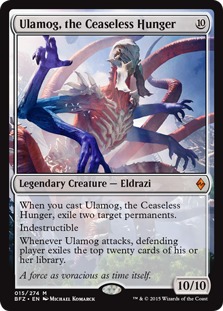Budget Magic: Oath of the Gatewatch Updates (10 Decks)
One thing I get asked all the time when a new set releases is updated lists for Budget Magic decks. As such, starting with Oath of the Gatewatch, I plan on publishing an update article for each non-rotation set release. Today we are going to cover all of the Standard Budget Magic lists published since the release of Battle for Zendikar and see what new cards fit into what decks. The butcgoal is to continue keeping the decks budget friendly. Just because Nissa, Voice of Zendikar or Kozilek's Return would be great in a deck doesn't mean we will automatically include them. That said, we have a little bit more leeway for two reasons. First, prices of new cards from Oath of the Gatewatch are inflated at the moment. Secondly some of our older Budget Magic decks are more expensive than they used to be. Anyway, let's get to the decks!

You know that hot new Eldrazi deck in Modern? We were playing something very similar on Budget Magic the very first week of Battle for Zendikar Standard! While I know the total price of the deck is over $100, this isn't the fault of the updates. Instead, the prices of the cards in the deck have increased significantly since we initially built it. All in all, the updated adds about $50 to the price of the deck, mostly for four copies of Thought-Knot Seer, which is absolutely insane in the deck.

The entire idea of Ulamog Exile was to use cheap exile effects like Silkwrap and Stasis Snare to fuel Eldrazi processors like Wasteland Strangler and Blight Herder, which in turn helps us ramp into Ulamog, the Ceaseless Hunger to finish the game. Thought-Knot Seer gives us a whole other avenue of attack, allowing us to process exiled cards from our opponent's hand. Thought-Knot Seer is especially important against hard to deal with threats like planeswalkers. While our deck has tons of ways of exiling creatures, the number of cards that exile a planeswalker are limited to Utter End and Quarantine Field. Thought-Knot Seer allows us to exile these cards proactively before they get a chance to hit the battlefield.



The other major change is the manabase, where we include a number of colorless producing lands which are necessary for us to play Thought-Knot Seer and our one copy of Endbringer. While I'm not sure if Endbringer will end up being good enough for constructed, I really want to try out a copy, and it slots easily into this deck. Oh yes, we also need colorless mana to cast our one copy of Kozilek, the Great Distortion, which we play over the third copy of Ulamog, the Ceaseless Hunger. While I think Ulamog, the Ceaseless Hunger will often be the better of the two Eldrazi, being able to cast an Ulamog, sacrifice a Sanctum of Ugin to get a Kozilek, the Great Distortion, and use it to refill our hand and counter anything relevant our opponent plays seems strong.
Read more about the deck including card choices, matchups and playtest videos in Budget Magic: $66 (51 tix) Ulamog Exile.

If there's one Budget Magic deck that gains the most from Oath of the Gatewatch, it's clearly Eldrazi Aggro. While this version is untested, it is very likely that a Devoid / Eldrazi Aggro deck will be at least tier two after rotation. The pieces are all there. Let's break it down!

I'm not sure it's possible to overstate how big of an addition Reaver Drone is to the deck. Before, we were playing jank like Sludge Crawler just because we were so desperate for a one drop to equip a Ghostfire Blade with on turn two. Now we have a legitimate one drop to fill his slot. Sure, it might make us lose a life once in awhile, but it really isn't a big issue. Outside of turn one we will typically have other colorless creatures to negate the downside. All in all, the printing of Reaver Drone in and of itself is a huge push towards respectability for the deck.


Almost as important as Reaver Drone are Bearer of Silence and Eldrazi Obligator. One of the problems with the original build of Eldrazi Aggro is that it was an all-in aggro deck, and most of its cards were fairly poor in the mid-to-late game. In Bearer of Silence and Eldrazi Obligator, we get cards that are not only fine on turn two (or three), but are good off the top in the late game as well. Bearer of Silence is pretty close to a Gatekeeper of Malakir without the super strict mana requirements. Bearer of Silence has evasion, so we can suit it up with Ghostfire Blade and start attacking for four in the air on turn three. Meanwhile, Eldrazi Obligator is pretty close to Zealous Conscripts when you play it on turn five. Remember, both of these abilities trigger when the card is cast. At minimum you get an uncounterable four-mana Diabolic Edict and an uncounterable five-mana Act of Treason.
The best news? The new build only costs $21 more than the original, for a total paper price of $62!
Read more about Eldrazi Aggro including cards choices, matchups and playtest videos in Budget Magic: $25 (3 tix) Eldrazi Aggro.

No major changes to this one. The only new card I'm really interested in testing is Oath of Jace, which may or may not be better than Monastery Siege. Over the course of several turns Monastery Siege is definitely the better card. The big advantage of Oath of Jace is that we get three Sphinx's Tutelage triggers at once for only three mana. For this update, I just cut a Dampening Pulse (which underperformed) and a single Ugin's Insight for the new legendary enchantment. Whether or not Oath of Jace makes the cut long-term remains to be seen.
Read more about the deck including card choices, matchups and playtest videos in Budget Magic: $42 (13 tix) Marshmallow Tutelage

I was this close to jamming four copies of Inverter of Truth into the deck. Consequences be damned, it is an extremely big creature on turn four. I mean, we spend a lot of time filling our graveyard, so it likely wouldn't kill us. But then I came back to my senses and realized we are better off using our graveyard for Dig Through Time. As such, we ended up with no changes.



That said, I did want to shout out a few cards specifically. If it wasn't for budget considerations, I'd definitely be playing some number of Hissing Quagmires. Thanks to Ulamog, the Ceaseless Hunger, this deck is on the high side of budget deck prices as it stands. Perhaps adding $10 for a set of GB creaturelands seems like too much. Speaking of Ulamog, the Ceaseless Hunger. In Reanimator we aren't getting the "when cast" trigger. Ulamog is 100 times better than Kozilek, the Great Distortion since he can't be chumped and is indestructible. So even with all the new fatties in Oath of the Gatewatch, Ulamog, the Ceaseless Hunger is clearly the best reanimation target in Standard (with all due respect to Dragonlord Atarka).
Read more about the deck including card choices, matchups and playtest videos in Budget Magic: $99 (58 tix) Standard Reanimator.

As you know I'm not a big fan of Crush of Tentacles in general, but it does seem to fit really, really nicely in Turbo Turns. It almost works as additional copies of Planar Outburst and offers another option for making a huge creature before starting the extra turn chain. It seems good enough, in fact, that I could picture building a straight Green-Blue version of the deck, and running four copies of Crush of Tentacles in the Planar Outburst slot.

The other card I'm really excited about is Linvala, the Preserver out of the sideboard. One of the things I really liked about Trubo Turns is that we have the option of bringing in Gaea's Revenge as a sideboard trump against control decks. In Linvala, the Preserver we now have a sideboard trump against aggro / midrange decks as well. Since we have so few creatures and don't deal damage until we go on the game winning extra turn loop, we will almost always get full value from Linvala, the Preserver. She puts eight power on the battlefield, which means we only need two extra turns to win the game with Linvala, the Preserver and her token attacking.
All in all, these changes make the deck more expensive, mostly because three copies of Linvala, the Preserver currently cost $14. At only $65 in paper, Turbo Turns is still a powerful, fun, and attractive budget option for the format.
Read more about the deck including card choices, matchups and playtest videos in Budget Magic: $57 (22 tix) Turbo Turns.

No new, low converted mana cost hexproof creatures and no sweet new auras means no new cards for Bogles.
Read more about the deck including card choices, matchups and playtest videos in Budget Magic: $24 (8 tix) Standard Bogles.

GB Value Leap definitely gets better with the arrival of Oath of the Gatewatch. While it only gets three new cards, they are impactful. First off, we get Flaying Tendrils out of the sideboard, which shores up weaknesses against go-wide strategies. While Merciless Executioner and Fleshbag Marauder are great at dealing with mid-to-late game creatures, they really hate to see Hordeling Outburst or Secure the Wastes across the table. Flaying Tendrils keeps the board clean while we value our opponent out of the game with Elvish Visionary, Greenwarden of Murasa, and Kalitas, Traitor of Ghet.

Kalitas, Traitor of Ghet looks amazing for GB Value Leap. Since the entire plan of the deck is to kill every creature our opponents play, Kalitas, Traitor of Ghet can generate an insurmountable tide of Zombies. Better yet, Kalitas shores up our weakness against graveyard decks like Four-Color Rally, which don't mind sacrificing a creature every turn. Kalitas, Traitor of Ghet shuts down Rally the Ancestors almost completely, much like Anafenza, the Foremost. Kalitas also helps against other popular cards like Den Protector and Deathmist Raptor, while also making delve costs a bit harder for our opponents to pay.

Finally, in GB Value Leap we have enough room under the budget to fit in four copies Hissing Quagmire. The creatureland is a huge addition to the deck, offering a strong defensive creature without taking up a creature slot. In a pinch we can sacrifice it to Evolutionary Leap, which is a fringe situation, but an upside nonetheless. Better yet, since we were already playing lands that enter the battlefield tapped, we don't lose any speed by including Hissing Quagmire. It's pure upside.
Read more about the deck including card choices, matchups and playtest videos in Budget Magic: $62 (24 tix) GB Value Leap.

While Oath of the Gatewatch adds a bunch of new Allies to the format, none of them really seem to fit in a Rally the Ancestors deck. The only addition I made was two copies of Ayli, Eternal Pilgrim, which offers a low-cost sacrifice outlet and a good body on turn two. She lets us remove Kor Bladewhirl from the deck, which often led to awkward situations with Drana, Liberator of Malakir. By giving our entire team first strike, Kor Bladewhirl negated the impact of Drana, Liberator of Malakir's crusade effect, which triggers on first strike damage.
Read more about the deck including card choices, matchups and playtest videos in Budget Magic: $54 (26 tix) Standard rAllies.

Unfortunatly, Oath of the Gatewatch didn't give us any new Savannah Lions, so changes to the deck are minimal. Thankfully, we get to remove Kytheon's Tactics, which was quite clunky in the deck, and replace it with Make a Stand. While Make a Stand doesn't offer the same power boost, it does give us some wrath protection and allows us to swing the team into any board state. Plus Make a Stand is an instant, which is a massive upgrade. Otherwise, we just replaced Celestial Flare with the mostly better Immolating Glare, which lets us choose which attacking creature to kill, rather than letting our opponent make the choice. Immolating Glare is worse against indestructible creatures like Ulamog, the Ceaseless Hunger, but if our opponent resolves an Ulamog, the Ceaseless Hunger we probably aren't winning anyway.
Read more about the deck including card choices, matchups and playtest videos in Budget Magic: $46 (22 tix) Standard Savannah Lions.


Clearly the biggest addition to Goblins is Reckless Bushwhacker, which offers another way of closing out the game on turn four. Being able to curve a one-drop into Dragon Fodder into Hordeling Outburst into Goblin Piledriver AND Reckless Bushwhacker on turn four seems like a free win. Reckless Bushwhacker is an easy replacement for Mardu Scout, which was mostly a filler two-drop. While Reckless Bushwhacker gives up a point of power, it has a ton more upside.

Owen Turtenwald posted a Stoneforge Masterwork Goblins build on ChannelFireball about a week ago, and he seemed very high on the equipment in the deck. His basic argument was that Stoneforge Masterwork turns any random Goblin (or Goblin token) into a must-be-dealt-with threat, which seems about right. Essentially, in a deck full of Hordeling Outbursts and Dragon Fodders, Stoneforge Masterwork offers a cheap and efficient way to build your own Goblin Piledriver.
While it obviously isn't as strong, I could imagine Stoneforge Masterwork playing a role similar to Cranial Plating in Modern Affinity. Both decks play a bunch of creature that are seemingly underpowered on their own, but when you have an equipment with a low equip cost that can turn a Ornithopter or Goblin Token into a lethal threat, you have the potential to win a lot of unwinnable games.
Read more about the deck including card choices, matchups and playtest videos in Budget Magic: $32 (5 tix) Standard Goblins.
Conclusion
Anyway, that's all for today. If you are looking for some new cards to update your Budget Magic decks, this article is where I'd start. If I come across any other sweet updates once Oath of the Gatewatch releases on Magic Online, I'll make sure to let all of you know. As always, leave your thoughts, ideas, opinions, and suggestions in the comments. You can reach me on Twitter (or MTGO) @SaffronOlive.













